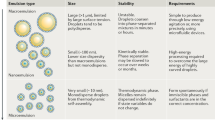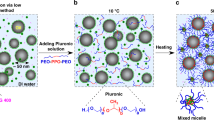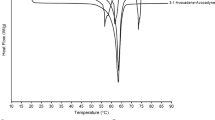Abstract
Water-in-oil-in-water emulsions are examples of double emulsions, in which dispersions of small water droplets within larger oil droplets are themselves dispersed in a continuous aqueous phase1,2,3. Emulsions occur in many forms of processing and are used extensively by the foods, cosmetics and coatings industries. Because of their compartmentalized internal structure, double emulsions can provide advantages over simple oil-in-water emulsions for encapsulation, such as the ability to carry both polar and non-polar cargos, and improved control over release of therapeutic molecules4,5,6. The preparation of double emulsions typically requires mixtures of surfactants for stability; the formation of double nanoemulsions, where both inner and outer droplets are under 100 nm, has not yet been achieved7,8,9. Here we show that water-in-oil-in-water double emulsions can be prepared in a simple process and stabilized over many months using single-component, synthetic amphiphilic diblock copolypeptide surfactants. These surfactants even stabilize droplets subjected to extreme flow, leading to direct, mass production of robust double nanoemulsions that are amenable to nanostructured encapsulation applications in foods, cosmetics and drug delivery.
This is a preview of subscription content, access via your institution
Access options
Subscribe to this journal
Receive 51 print issues and online access
$199.00 per year
only $3.90 per issue
Buy this article
- Purchase on Springer Link
- Instant access to full article PDF
Prices may be subject to local taxes which are calculated during checkout



Similar content being viewed by others
References
Bibette, J., Calderon, F. L. & Poulin, P. Emulsions: Basic principles. Rep. Prog. Phys. 62, 969–1033 (1999)
Ficheux, M. F., Bonakdar, L., Leal-Calderon, F. & Bibette, J. Some stability criteria for double emulsions. Langmuir 14, 2702–2706 (1998)
Wang, Y. F., Tao, Z. & Gang, H. Structural evolution of polymer-stabilized double emulsions. Langmuir 22, 67–73 (2006)
Pays, K. et al. Double emulsions: how does release occur? J. Control. Release 79, 193–205 (2002)
Davis, S. S. & Walker, I. M. Multiple emulsions as targetable delivery systems. Methods Enzymol. 149, 51–64 (1987)
Okochi, H. & Nakano, M. Preparation and evaluation of W/O/W type emulsions containing vancomycin. Adv. Drug Deliv. Rev. 45, 5–26 (2000)
Garti, N. Double emulsions: Scope, limitations and new achievements. Colloids Surf. A 123, 233–246 (1997)
Loscertales, I. G. et al. Micro/nano encapsutation via electrified coaxial liquid jets. Science 295, 1695–1698 (2002)
Utada, A. S. et al. Monodisperse double emulsions generated from a microcapillary device. Science 308, 537–541 (2005)
Morais, J. M., Santos, O. D. H., Nunes, J. R. L., Zanatta, C. F. & Rocha-Filho, P. A. W/O/W multiple emulsions obtained by one-step emulsification method and evaluation of the involved variables. J. Disp. Sci. Technol. 29, 63–69 (2008)
Mason, T. G., Wilking, J. N., Meleson, K., Chang, C. B. & Graves, S. M. Nanoemulsions: formation, structure, and physical properties. J. Phys. Condens. Matter 18, R635–R666 (2006)
Goubault, C. et al. Shear rupturing of complex fluids: Application to the preparation of quasi-monodisperse water-in-oil-in-water double emulsions. Langmuir 17, 5184–5188 (2001)
Okushima, S., Nisisako, T., Torii, T. & Higuchi, T. Controlled production of monodisperse double emulsions by two-step droplet breakup in microfluidic devices. Langmuir 20, 9905–9908 (2004)
Benichou, A., Aserin, A. & Garti, N. Double emulsions stabilized with hybrids of natural polymers for entrapment and slow release of active matters. Adv. Colloid Interface Sci. 108–109, 29–41 (2004)
Katchalski, E. & Sela, M. Synthesis and chemical properties of poly-alpha-amino acids. Adv. Protein Chem. 13, 243–492 (1958)
Niederhafner, P., Šebestík, J. & Ježek, J. Peptide dendrimers. J. Pept. Sci. 11, 757–788 (2005)
Nowak, A. P. et al. Rapidly recovering hydrogel scaffolds from self-assembling diblock copolypeptide amphiphiles. Nature 417, 424–428 (2002)
Holowka, E. P., Pochan, D. J. & Deming, T. J. Charged polypeptide vesicles with controllable diameter. J. Am. Chem. Soc. 127, 12423–12428 (2005)
Kricheldorf, H. R. & Mang, T. C-13-NMR sequence-analysis, 20. Stereospecificity of the polymerization of D,L–Leu-NCA and D,L–Val-NCA. Makromol. Chem.: Macromol. Chem. Phys. 182, 3077–3098 (1981)
Breitenbach, J. W., Allinger, K. & Koref, A. Viskositätsstudien an Lösungen von DL-Phenylalanin-Polypeptiden. Monatsh. Chem. 86, 269 (1955)
Lapp, C. & Marchal, J. Preparation de la poly-D,L-phenylalanine en helice par polymerisation de la D,L-benzyl-4 oxazolidine dione-2–5. J. Chim. Phys. 60, 756–766 (1963)
Kataoka, K., Kwon, G. S., Yokoyama, M., Okano, T. & Sakurai, Y. Block-copolymer micelles as vehicles for drug delivery. J. Control. Release 24, 119–132 (1993)
Strey, R. Microemulsion microstructure and interfacial curvature. Colloid Polym. Sci. 272, 1005–1019 (1994)
Enser, M., Bloomberg, G. B., Brock, C. & Clark, D. C. De novo design and structure-activity relationships of peptide emulsifiers and foaming agents. Int. J. Biol. Macromol. 12, 118–124 (1990)
Dickinson, E. Structure and composition of adsorbed protein layers and the relationship to emulsion stability. J. Chem. Soc., Faraday Trans. 88, 2973–2983 (1992)
Saito, M., Ogasawara, M., Chikuni, K. & Shimizu, M. Synthesis of a peptide emulsifier with an amphiphilic structure. Biosci. Biotechnol. Biochem. 59, 388–392 (1995)
Dalgleish, D. G. Conformations and structures of milk proteins adsorbed to oil-water interfaces. Food Res. Intl 29, 541–547 (1996)
Chang, C. B., Knobler, C. M., Gelbart, W. M. & Mason, T. G. Curvature dependence of viral protein structures on encapsidated nanoemulsion droplets. ACS Nano 2, 281–286 (2008)
Carragher, B. et al. Leginon: An automated system for acquisition of images from vitreous ice specimens. J. Struct. Biol. 132, 33–45 (2000)
Zuidema, H. H. & Waters, G. W. Ring method for the determination of interfacial tension. Ind. Eng. Chem. Anal. Edn 13, 312–313 (1941)
Acknowledgements
This work is supported by a grant from the National Science Foundation (T.J.D.), a grant from the Human Frontiers of Science Program (T.J.D.), and University of California start-up funds (T.J.D. and T.G.M.). Some of the work was conducted at the National Resource for Automated Molecular Microscopy (NRAMM) which is supported by the National Institutes of Health through the National Center for Research Resources P41 programme. We thank C. Potter and J. Quispe of NRAMM at the Scripps Research Institute, and S. Zhong and D. Pochan of the University of Delaware, for use of cryoelectron microscopy equipment.
Author Contributions J.A.H. synthesized the polypeptides, prepared and characterized the emulsions, designed experiments, and assisted in manuscript preparation. C.B.C and S.M.G. also prepared and characterized the emulsions. Z.L. imaged the emulsions using CTEM. T.G.M. and T.J.D. initiated the project, designed and supervised the experiments, analysed the data, and drafted the manuscript. T.J.D. assembled and finalized the manuscript. All authors discussed the results and commented on the manuscript.
Author information
Authors and Affiliations
Corresponding authors
Supplementary information
Supplementary Information
The file contains Supplementary Methods, Supplementary Table 1, Supplementary Figures 1-6 with Legends. Text of synthetic methods and additional details on emulsion preparation. The Supplementary Table gives characterization of block copolypeptide surfactants. The Supplementary Figures show additional details of polypeptide surfactants including variations of amino acid composition, emulsion stability, emulsion size, and control of internal droplet structure. (PDF 1679 kb)
Rights and permissions
About this article
Cite this article
Hanson, J., Chang, C., Graves, S. et al. Nanoscale double emulsions stabilized by single-component block copolypeptides. Nature 455, 85–88 (2008). https://doi.org/10.1038/nature07197
Received:
Accepted:
Issue Date:
DOI: https://doi.org/10.1038/nature07197
This article is cited by
-
Regulating the Oil-Water Interface to Construct Double Emulsions: Current Understanding and Their Biomedical Applications
Chemical Research in Chinese Universities (2022)
-
A moisture-tolerant route to unprotected α/β-amino acid N-carboxyanhydrides and facile synthesis of hyperbranched polypeptides
Nature Communications (2021)
-
The vortex-driven dynamics of droplets within droplets
Nature Communications (2021)
-
Multiple Emulsions for Enhanced Delivery of Vitamins and Iron Micronutrients and Their Application for Food Fortification
Food and Bioprocess Technology (2021)
-
Multiple nanoemulsions
Nature Reviews Materials (2020)
Comments
By submitting a comment you agree to abide by our Terms and Community Guidelines. If you find something abusive or that does not comply with our terms or guidelines please flag it as inappropriate.



